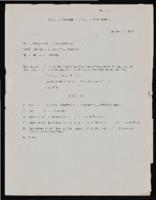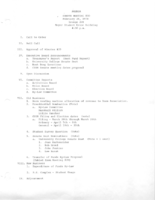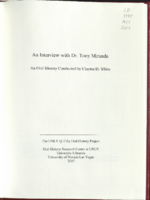Search the Special Collections and Archives Portal
Search Results
Lawrence Revere Papers
Identifier
Abstract
The Lawrence Revere Papers primarily consist of correspondence between Lawrence Revere and the developers of blackjack betting systems dating from 1965 to 1970. The collection includes information about blackjack gambling systems, correspondence with gambling experts, and press material regarding the publication of Revere's book
Archival Collection
Castaways Hotel and Casino Photograph Collection
Identifier
Abstract
The Castaways Hotel and Casino Photograph Collection, approximately 1963 to 1987, consists of black-and-white and color photographic prints and negatives. Images depict the exterior of the entrance to the property, the mega-pylon sign, the pool area, and the “Gateway to Luck” replica temple in the courtyard area. The interior images depict various hotel rooms and suites, a couple dining, and a performance by Rusty Isabel, an entertainer in the Kon Tiki Lounge inside the property.
Archival Collection
Paul J. Richert Photograph Collection
Identifier
Abstract
The Paul J. Richert Photograph Collection (approximately 1950-1951) consists of black-and-white photographic prints and negatives depicting the swimming pools at the Desert Inn and Flamingo Hotel & Casino in Las Vegas, Nevada. Also included is an image of the Las Vegas High School Rhythmettes dance group and an image of the El Rancho Hotel and Casino in Las Vegas.
Archival Collection
Nadine Tobin Collection of Helldorado Photographs
Identifier
Abstract
The Nadine Tobin Collection of Helldorado Photographs, approximately 1940 to 1959, contains black-and-white photographic prints depicting parade floats during Helldorado Days celebrations in Las Vegas, Nevada. Also included is one image of a primary school class in Las Vegas.
Archival Collection
First Good Shepherd Lutheran Church Photograph Collection
Identifier
Abstract
The First Good Shepherd Lutheran Church Photograph Collection, approximately 1930 to 1950, consists of black-and-white photographic prints and negatives depicting the construction of the Good Shepherd Lutheran Church in Las Vegas, Nevada. Also included are images of parish leaders and the ground breaking ceremony for the grand opening.
Archival Collection

Economic Opportunity Board of Clark County (Nev.): memos, agendas, and meeting minutes
Date
Archival Collection
Description
From the Clark County Economic Opportunity Board Records -- Series I. Administrative. This folder contains memos, agendas and minutes from meetings of the Clark County Economic Opportunity Board from January 1970 through February 1970.
Text

Meeting minutes for Consolidated Student Senate, University of Nevada, Las Vegas, February 28, 1978
Date
Archival Collection
Description
Text

Patricia Vazquez interview, November 14, 2018, June 14, 2019: transcript
Date
Archival Collection
Description
Session 1: Interviewed by Marcela Rodriguez-Campo. Barbara Tabach also participates in the questioning. Session 2: Interviewed by Rodrigo Vazquez. Monserrath Hernandez also participates in the questioning. Patricia Vazquez was born and raised in Las Vegas, NV and shares her experiences growing up in the Valley as a Queer Latina. At a young age, she remembers traveling back and forth between Mexico and the U.S. to visit family. When she started school she shares how her home language, Spanish, became her family's "secret language" as she began to learn English. During elementary school Patricia was tracked into the special education program, and remove from the mainstream classroom. She would find her love for learning in books and libraries as she taught herself how to read in English. Despite being tracked into less advanced courses, Patricia would end up taking AP/ Honors courses in high school after forging her favorite teachers signature, which changed her educational trajectory. After coming out to her family, Patricia went nearly a decade distanced from her mother and continued her college education at Arizona State University. There, she would complete a bachelors in painting and a masters in comparative literature. Her work with the Chicano Studies program at ASU helped her develop her Chicana identity and begin her involvement in social activism. In Las Vegas, she worked to fight for marriage equality and LGBTQ rights with the American Civil Liberties Union , and later with the Progressive Leadership Alliance of Nevada. She also conducted several lectures for the Latino Youth Leadership Conference on sexuality, gender, and homophobia for over a decade. She has served as an English Professor at the College of Southern Nevada for the last 20 years and is an avid hiker, traveler, and painter.
Text

Interview with Edward Bonfoy Giller, April 19, 2006
Date
Archival Collection
Description
Text

Transcript of interview with Dr. Tony Miranda by Claytee D. White, July 24, 2006
Date
Archival Collection
Description
Text
